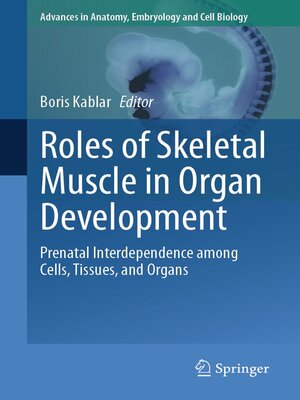Roles of Skeletal Muscle in Organ Development
ebook ∣ Prenatal Interdependence among Cells, Tissues, and Organs · Advances in Anatomy, Embryology and Cell Biology
By Boris Kablar

Sign up to save your library
With an OverDrive account, you can save your favorite libraries for at-a-glance information about availability. Find out more about OverDrive accounts.
Find this title in Libby, the library reading app by OverDrive.



Search for a digital library with this title
Title found at these libraries:
| Library Name | Distance |
|---|---|
| Loading... |
Muscle is the only tissue of the four basic types that make the body that can be completely ablated while allowing fetal survival. This book is a result of 25 years of research employing engineered mouse fetuses with no skeletal muscle, a model system that provides a unique opportunity to study body development holistically.
A systematic anatomical analysis of such fetuses have shown that several anatomical locations are affected by the absence of the skeletal muscle. This book contains a summarized description of affected anatomical locations such as the alveolar lung epithelium, motor neurons and giant pyramidal cells in the CNS, cholinergic amacrine cells of the retina, and type I hair cells of the crista ampullaris. Several specific bioinformatics and systems biology interventions are also described. The book provides an update on skeletal muscle development, musculoskeletal developmental interactions, trophic relationships between the skeletal muscle and the motor neurons, mechanics of lung development, functional development of two special senses, eye and ear, and finally, skeletal muscle-related reasons for human fetal akinesia and its consequences.
This volume in the Advances in Anatomy, Embryology and Cell Biology series stresses the need to think about the developing body and its organs in terms of their mutual interdependence, and to think about diseases, such as pulmonary hypoplasia, amyotrophic lateral sclerosis, or cleft palate, in terms of that interdependence. Directed to developmental biologists, neuroscientists, tissue engineers and health professionals, this book exposes the ideas of interorgan communication and interdependence in homeostasis and disease.







